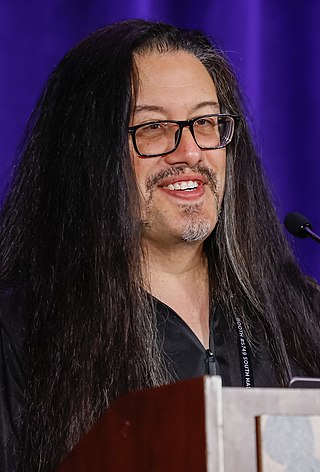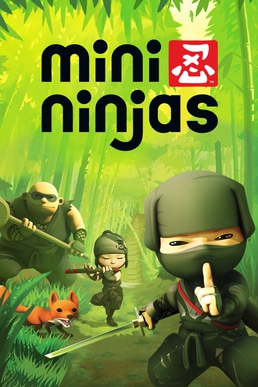
id Software LLC is an American video game developer based in Richardson, Texas. It was founded on February 1, 1991, by four members of the computer company Softdisk: programmers John Carmack and John Romero, game designer Tom Hall, and artist Adrian Carmack.

Quake II is a 1997 first-person shooter video game developed by id Software and published by Activision. It is the second installment of the Quake series, following Quake. The game's storyline is continued in its expansions, including one tying in Quake II and the first game, and Quake 4.

Quake is a first-person shooter game developed by id Software and published by GT Interactive. The first game in the Quake series, it was originally released for MS-DOS, Microsoft Windows and Linux in 1996, followed by Mac OS and Sega Saturn in 1997 and Nintendo 64 in 1998. In the game, players must find their way through various maze-like, medieval environments while battling monsters using an array of weaponry. Quake takes inspiration from gothic fiction and the works of H. P. Lovecraft.

Stevana "Stevie" Case is an American businesswoman. She is known for competing in the first-person shooter game Quake in the late 1990s, as well as contributing professionally to the video game industry.

Tom Clancy's Rainbow Six is a 1998 tactical shooter video game developed and published by Red Storm Entertainment for Microsoft Windows, with later ports for the Nintendo 64, PlayStation, Mac OS, Game Boy Color, and Dreamcast. It is the first installment in the Rainbow Six series. Based on the Tom Clancy novel of the same name, the game follows Rainbow, a secret international counterterrorist organization, and the conspiracy they unravel as they handle a seemingly random spike in terrorism.

Alfonso John Romero is an American director, designer, programmer and developer in the video game industry. He is a co-founder of id Software and designed their early games, including Wolfenstein 3D (1992), Doom (1993), Doom II (1994), Hexen (1995) and Quake (1996). His designs and development tools, along with programming techniques developed by id Software's lead programmer, John Carmack, popularized the first-person shooter (FPS) genre. Romero is also credited with coining the multiplayer term "deathmatch".

Ion Storm, L.P. was an American video game developer founded by John Romero and Tom Hall, both formerly of id Software. Despite an impressive pedigree and high expectations, the company only produced one commercial and critical success, 2000's Deus Ex.
Tom Hall is an American game designer best known for his work with id Software on titles such as Doom and Commander Keen.

Anachronox is a 2001 role-playing video game produced by Tom Hall and the Dallas Ion Storm games studio. The game is centered on Sylvester "Sly Boots" Bucelli, a down-and-out private investigator who looks for work in the slums of Anachronox, a once-abandoned planet near the galaxy's jumpgate hub. He travels to other planets, amasses an unlikely group of friends, and unravels a mystery that threatens the fate of the universe. The game's science fiction story was influenced by cyberpunk, film noir, and unconventional humor. The story features a theme of working through the troubles of one's past.

Warren Evan Spector is an American role-playing and video game designer, director, writer, producer and production designer. He is known for creating immersive sim games, which give players a wide variety of choices in how to progress. Consequences of those choices are then shown in the simulated game world in subsequent levels or missions. He is best known for the critically acclaimed video game Deus Ex that embodies the choice and consequence philosophy while combining elements of the first-person shooter, role-playing, and adventure game genres. In addition to Deus Ex, Spector is known for his work while employed by Looking Glass Studios, where he was involved in the creation of several acclaimed titles including Ultima Underworld, Ultima Underworld II, System Shock, and Thief: The Dark Project. He is employed by OtherSide Entertainment, where he was part of the development team for now-cancelled System Shock 3. He is currently working on a new immersive sim based on an original intellectual property.

Monkeystone Games was a video game developer and publisher founded by John Romero, Tom Hall, Stevie Case, and Brian Moon. After its inception in July 2001, Monkeystone published several titles on multiple platforms.
Doom WAD is the default format of package files for the video game Doom and its sequel Doom II: Hell on Earth, that contain sprites, levels, and game data. WAD stands for Where's All the Data? Immediately after its release in 1993, Doom attracted a sizeable following of players who created their own mods for WAD files—packages containing new levels or graphics—and played a vital part in spawning the mod-making culture which is now commonplace for first-person shooter games. Thousands of WADs have been created for Doom, ranging from single custom levels to full original games; most of these can be freely downloaded over the Internet. Several WADs have also been released commercially, and for some people the WAD-making hobby became a gateway to a professional career as a level designer.

Masters of Doom: How Two Guys Created an Empire and Transformed Pop Culture is a 2003 book by David Kushner about video game company id Software and its influence on popular culture, focusing on co-founders John Carmack and John Romero. The book goes into detail about the company's early years, the success of their franchises such as Doom, and the dynamics between Carmack and Romero and their different personalities. The book also focuses on Romero's firing and the founding and the eventual collapse of his game studio Ion Storm.

Dominion: Storm Over Gift 3 is a military science fiction real-time strategy video game developed by Ion Storm, published by Eidos Interactive, and released for Microsoft Windows in 1998. The game was originally developed as a spin-off of the mech simulation game G-Nome by 7th Level. Ion Storm acquired both Dominion and its lead designer, Todd Porter, from 7th Level for completion.

Mini Ninjas is a 2009 action-adventure game developed by IO Interactive and published by Eidos Interactive for Microsoft Windows, Nintendo DS, PlayStation 3, Wii and Xbox 360. A Mac OS X version of the game was released on July 8, 2010, by Feral Interactive. In December 2011, it was announced that the game would be also made available as a browser game for Google Chrome.

Will Loconto is a musician, composer, and producer based in Austin, Texas. He is the lead vocalist/songwriter for the U.S. band T42, was a keyboardist for the band Information Society, and has composed music for various video game soundtracks including Daikatana.

Blackroom was a planned first-person shooter game from the independent studio Night Work Games, created by former id Software developers John Romero and Adrian Carmack. It was planned to be crowdfunded on the Kickstarter platform, but the crowdfunding campaign was cancelled in April 2016. The game was set to launch during the winter quarter of 2018. In 2023, it was confirmed to be cancelled.

Romero Games Ltd. is an Irish independent video game development studio that was established on 11 August 2015 by husband-and-wife team John Romero and Brenda Romero and is located in Galway, Ireland. This is the ninth game studio Romero has established in his career, and currently it has released four titles.

Daikatana is a 2000 action-adventure game developed by Will and published by Kemco for the Game Boy Color. It is based on the first-person shooter of the same name, which was released earlier in 2000. Players control a swordsmaster who travels through various time periods in an effort to obtain the eponymous Daikatana, a powerful sword tied to the fate of the world.



















